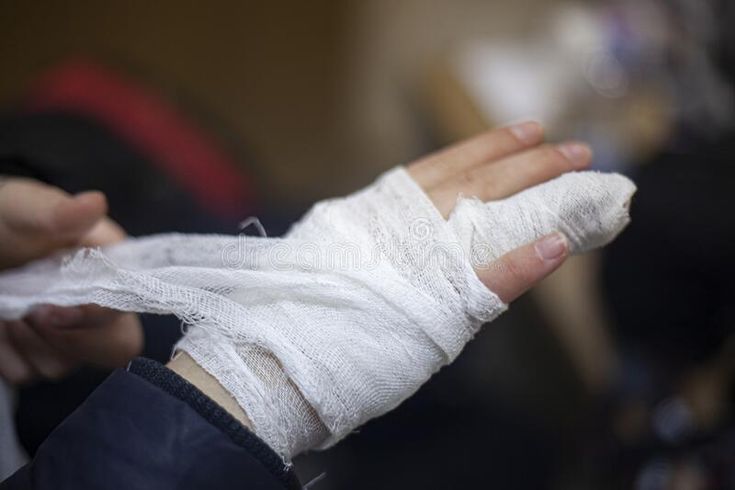Injuries and cuts are common, especially with kids. When it comes to bandaging up the wound, though, many of us don’t know where to start. Fortunately, this article will provide a step-by-step guide on how to correctly apply a bandaged hand at home – allowing for quick healing and giving you peace of mind!
What is a Bandaged Hand at Home?

If you have a cut or scrape on your hand, you may need to bandage it. This will help keep the area clean and protected from further injury. Follow these steps to bandage a hand at home:
1. Wash your hands thoroughly with soap and water.
2. Apply an antibiotic ointment to the wound if desired.
3. Place a piece of gauze over the wound and wrap it in place with medical tape or adhesive bandages.
4. Repeat step 3 as needed, depending on the size of the wound, until the entire hand is covered.
5. Check the bandage frequently and replace it as needed.
A bandaged hand at home is a great way to keep your hand clean and protected while you heal from an injury. Here is a step-by-step guide on how to properly bandage your hand at home:
1) Wash your hands thoroughly with soap and water before beginning.
2) Gather all of the supplies you will need: Band-Aids, gauze, medical tape, scissors.
3) Cut the gauze into strips that are long enough to wrap around your entire hand.
4) Place the gauze strips over the injured area, making sure to cover all cuts and scrapes.
5) Wrap the medical tape around the gauze to secure it in place.
6) Place a Band-Aid over any areas where the gauze is not covering the injury completely.
7) Repeat steps 2-6 as necessary until your hand is fully covered and protected.
Introduction to the Bandaged Hand At Home
If you have ever had the misfortune of injuring your hand, you know that the process of healing can be both painful and inconvenient. A bandaged hand is often the best course of treatment to promote healing and prevent infection. But when you are stuck at home with a bandaged hand, everyday tasks can become difficult.
In this blog post, we will provide a step-by-step guide on how to properly care for your bandaged hand at home. We will cover everything from how to change your bandage to what activities you should avoid while your hand is healing. By following these simple instructions, you can ensure that your hand heals properly and as quickly as possible.
Assuming you have a bandaged hand at home, there are a few things you can do to make sure it stays clean and protected. Here is a step-by-step guide:
1. Keep the bandage dry and clean. Change it if it gets wet or dirty.
2. Inspect the wound daily. Check for any signs of infection, such as redness, swelling, or drainage.
3. Keep the wound clean and dry. Apply an antibiotic ointment if directed by your healthcare provider.
4. Change the bandage as directed by your healthcare provider.
5. If you have any questions or concerns, contact your healthcare provider.
Step-by-Step Instructions
If you have a minor cut or scrape on your hand, you can easily bandage it at home. All you need is a bandage and some tape. Follow these steps to bandage your hand:
1. Wash your hands with soap and water. This will help prevent infection.
2. Apply pressure to the wound with a clean cloth to stop any bleeding.
3. Place the bandage over the wound and secure it in place with tape.
4. Repeat Steps 2-3 if necessary.
5. Check the wound regularly and replace the bandage as needed.
If you have a minor cut or injury on your hand, you can easily treat it at home with a bandage. Here is a step-by-step guide on how to apply a bandage to your hand:
1. Start by cleansing the wound with soap and water. This will help to remove any dirt or bacteria that could cause an infection.
2. Apply pressure to the wound with a clean cloth to stop any bleeding.
3. If the wound is deep, you may need to put on a sterile gauze pad before applying the bandage.
4. Wrap the bandage around the affected area, making sure not to wrap it too tightly. You should be able to slip one finger under the bandage.
5. Secure the bandage in place with adhesive tape or a Band-Aid.
6. Wash your hands thoroughly after applying the bandage, and check the wound regularly for any signs of infection, such as redness, swelling, or pus.
How to Put on a Bandaged Hand at Home of the Wrist

If you have a bandaged hand at home, it is important to know how to put it on correctly. Here is a step-by-step guide:
1. Start by washing your hands thoroughly with soap and water.
2. Next, remove any jewelry from your hand, including rings and watches.
3. Then, gently position the bandage on your hand so that it covers the affected area.
4. Use one hand to hold the bandage in place, while you use your other hand to wrap the bandage around your wrist. Make sure the bandage is snug but not too tight.
5. Once the bandage is in place, secure it with tape or a Band-Aid® brand adhesive bandage.
6. Finally, wash your hands again with soap and water to remove any residue from the tape or adhesive bandage.
If you have a bandaged hand at home, it is important to know how to properly put on and take off the bandage. Here is a step-by-step guide on how to put on a bandaged hand at home of the wrist:
1. Start by washing your hands with soap and water. This will help prevent infection.
2. Next, remove any jewelry from your affected hand.
3. If your bandage has a adhesive strip, peel it off before applying the bandage.
4. Wrap the middle part of the bandage around your palm, making sure to cover all fingers except for the thumb.
5. Take the end of the bandage and wrap it around your wrist several times, securing it in place with an adhesive strip or tape.
6. Finally, check that all fingers are covered and that the bandage is not too tight. You should be able to move your fingers without too much difficulty.
What to Do If You Have an Injury: Symptoms and Treatment Plans
If you have an injury, it’s important to know the symptoms and treatment options so you can get the care you need.
Symptoms:
– pain at the site of the injury
– swelling
– bruising
– limited range of motion
Treatment plans:
– Rest: Take a break from any activity that is causing pain. This will help your body heal.
– Ice: Apply ice to the injured area for 15 minutes at a time, several times a day. This will help reduce swelling.
– Compression: Use an elastic bandage or wrap to support and immobilize the injured area. This will help reduce swelling.
– Elevation: Raise the injured area above heart level to help reduce swelling.
If you have any of these symptoms, it’s important to see a doctor so they can properly diagnose and treat your injury.




Your article helped me a lot, is there any more related content? Thanks! https://www.binance.com/sk/join?ref=RQUR4BEO
Your article helped me a lot, is there any more related content? Thanks!
Your article helped me a lot, is there any more related content? Thanks!
Thank you for your sharing. I am worried that I lack creative ideas. It is your article that makes me full of hope. Thank you. But, I have a question, can you help me?
I don’t think the title of your article matches the content lol. Just kidding, mainly because I had some doubts after reading the article.